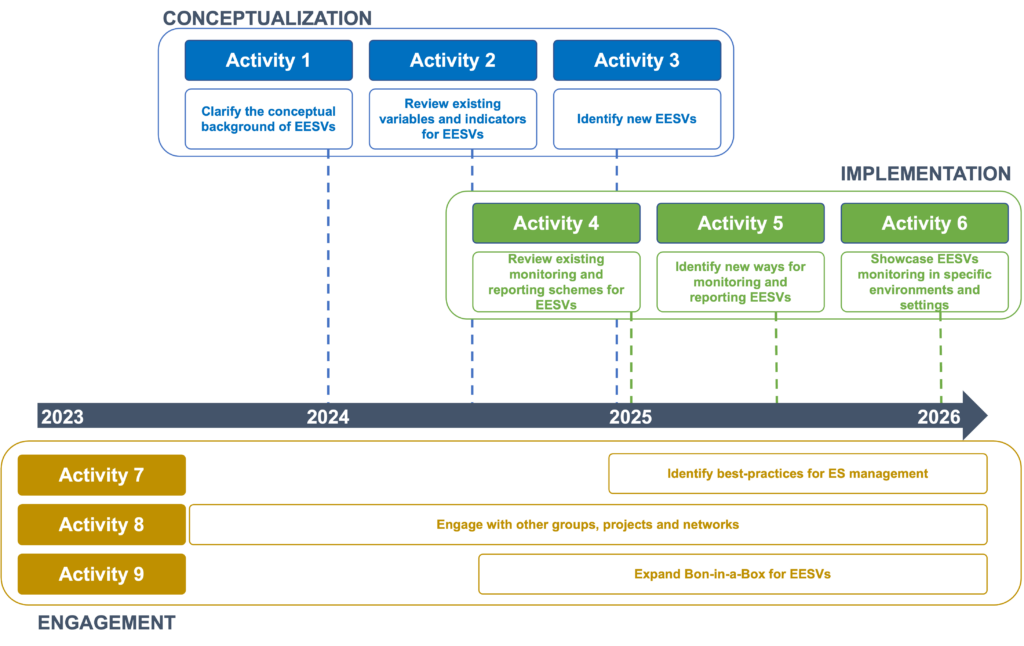Biodiversity and ecosystem changes are having consequences on the services and benefits that ecosystems contribute to people’s quality of life. The GEO BON Ecosystem Services Working Group (ESWG) aims to detect, understand, and predict patterns of ecosystem services change by monitoring their trends. Such scope requires a better understanding of the links between biodiversity and ecosystem functioning, as well as going beyond biophysical considerations on the quantification of natural systems in order to include multiple trade-offs, scales, and social dimensions, and hence to support appropriate policy and practices across multiple stakeholders, from governments and businesses, to civil society. To do so, the ESWG embraces complementary visions from different disciplines and state-of-the art technologies to observe, identify, describe, and explore trends in social-ecological systems and ecosystem services. This inevitably requires the definition of ecosystem services’ dimensions, their variables, and indicators, as well as advancing how ecosystem services can be feasibly measured across different habitats, biomes, and regions. To do so, the ESWG seeks to strengthen collaboration and participatory processes with national, regional, and global business and governmental actors, who, through their policies and actions, can influence institutional structures, management practices and human behavior, while continuing to strengthen its academic and scientific foundations.
See implementation plan 2023-2026.
About Ecosystem Services WGCo-Leads
 A. Sofia Vaz
A. Sofia VazCIBIO-University of Porto
 Nuria Piston
Nuria PistonUniversidad de Granada
Key objectives
- Define and expand the conceptual basis of Essential Ecosystem Services Variables (EESVs), and their links with Essential Biodiversity Variables (EBVs) as well as with social, cultural, economic and knowledge-based systems.
- Operationalize and promote the use of Essential Ecosystem Service Variables (EESVs) in monitoring schemes from local to global scales.
- Engage and promote synergies with other initiatives, projects, and networks focused on ecosystem services, such as in business, government, civil society, education, and research.

OBJECTIVE 1. CONCEPTUALIZATION

McGill University
Activity 1. Clarify the conceptual background of EESVs:
This activity aims at reviewing already existing data, variables and indicators from other systems, commitments or reportings (such as EBVs, economic accounting, anthropogenic use), that can be used to inform and measure EESVs (both ecological and human dimensions).
Activity 2. Review existing variables and indicators for EESVs
This activity aims at reviewing already existing data, variables and indicators from other systems, commitments or reportings (such as EBVs, economic accounting, anthropogenic use), that can be used to inform and measure EESVs (both ecological and human dimensions).
Activity 3. Identify new EESVs
This activity aims at critically identifying which gaps need to be addressed to inform and measure existing EESVs, and how they can be tackled, including the identification of new EESVs and the required data, variables and indicators.
OBJECTIVE 2. IMPLEMENTATION

McGill University
Activity 4. Review existing monitoring and reporting schemes for EESVs
This activity aims at checking monitoring, accounting and reporting schemes (including governmental and business initiatives and commitments) dealing with ecosystem services indicators and variables that can be linked with already existing and new EESVs at their appropriate spatial and temporal scales.
Activity 5. Identify new ways for monitoring and reporting EESVs
This activity aims to identify novel ways to monitor (and report on) ecosystem services, using new technologies (eDNA, citizen science, social media, remote sensing) to address existing and new EESVs.
Activity 6. Showcase EESVs monitoring in specific environments and settings
This activity aims to illustrate and evaluate the operationalization of EESVs and indicators, through a set of joint application cases in specific environments and settings such as urban systems, arid and semi-arid regions, or the tropics (among others to be defined).
OBJECTIVE 3. ENGAGEMENT

CIBIO-University of Porto
Activity 7. Identify best-practices for ES management
This activity aims to identify best-practices that promote ecosystem services management and their resilience, across ecosystem types and scales, while setting up orientations for measuring such practices through EESVs.
Activity 8. Engage with other groups, projects and networks
This activity aims to organize a series of initiatives (e.g. webinars, conference participation) with governmental, research and business networks and groups focused on ecosystem services, in order to account for different sectors needs and visions on EESVs as well as to promote EESVs application.
Activity 9. Expand Bon-in-a-Box for EESVs
Can an EESVs database be developed (in support of a Bon-in-a-Box and GBioS)? Which meta-data may be necessary to report for ES products to support transparency and replicability?
Hölting L, Jacobs S, Felipe-Lucia Maria R, Maes J, Norström Albert V, Plieninger T, and Cord Anna F. 2019. “Measuring ecosystem multifunctionality across scales”. 14 (12). | https://doi.org/10.1088/1748-9326/ab5ccb
Geijzendorffer, Ilse R., Coralie Beltrame, Laurent Chazee, Elie Gaget, Thomas Galewski, Anis Guelmami, Christian Perennou, et al. 2019. “A More Effective Ramsar Convention for the Conservation of Mediterranean Wetlands”. Frontiers in Ecology and Evolution. 7. Download as PDF | https://doi.org/10.3389/fevo.2019.00021
Haase, Peter, Jonathan D. Tonkin, Stefan Stoll, Benjamin Burkhard, Mark Frenzel, Ilse R. Geijzendorffer, Christoph Häuser, et al. 2018. “The next generation of site-based long-term ecological monitoring: Linking essential biodiversity variables and ecosystem integrity”. Science of the Total Environment. 613-614: 1376-1384. Email me a PDF
Geijzendorffer I.R., van Teeffelen A.J., Allison H., Braun D., Horgan K., Iturrate-Garcia M., et al. 2017. “How can global conventions for biodiversity and ecosystem services guide local conservation actions?” Current Opinion in Environmental Sustainability. 29: 145-150. Email me a PDF | doi.org/10.1016/j.cosust.2017.12.011
Geijzendorffer Ilse R., Cohen-Shacham Emmanuelle, Cord Anna F., Cramer Wolfgang, Guerra Carlos, Martín-López Berta. 2017. “Ecosystem services in global sustainability policies”. Environmental Science and Policy. 74: 40-48. Email me a PDF
Brummitt, Neil, Eugenie C. Regan, Lauren V. Weatherdon, Corinne S. Martin, Ilse R. Geijzendorffer, Duccio Rocchini, Yoni Gavish, Peter Haase, Charles J. Marsh, and Dirk S. Schmeller. 2017. “Taking stock of nature: Essential biodiversity variables explained”. Biological Conservation. 213: 252-255. Email me a PDF
WG Ecosystem Services is linked to the NASA project:

